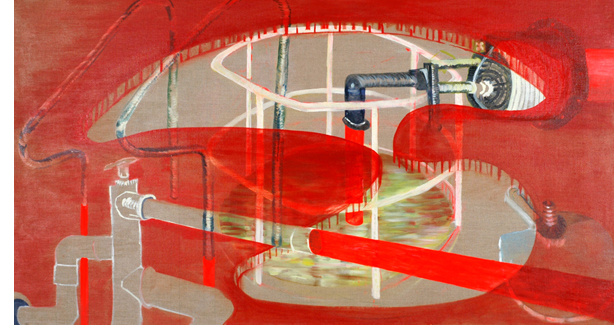ABOVE: Kevin Kelly, Rhizome Holes, oil on linen, 3'x5.5', 2006.
Cliff Eyland: MAZE is an exhibition that features new tenure-track and one recently tenured faculty. For people who don't know, could you tell us what "tenure-track" and "tenure" mean, and could you tell us about how you became a tenure-track professor?
Kevin Kelly: "Tenure-track" is probationary and
"tenure" is a permanent position.
Cliff Eyland: Do you identify primarily as an "artist" or as a "professor" or both?
Kevin Kelly: Artist and then professor.
Cliff Eyland: Can you tell us about how you became a professor? As a young artist did you think that you'd become an art professor?
Kevin Kelly: I feel that I have an innate desire to teach, I like it a lot and truly enjoy interacting with students in terms of creation and ideas. I have wanted to be a professor for 25 years, when I was a kid I wanted to be a teacher.
Cliff Eyland: What is it like to be an art professor in Winnipeg?
Kevin Kelly: Winnipeg is a great place to teach, a lot of young very surprising creative minds. I suspect it has something to do with the cold winters and the oasis nature of our location.
Cliff Eyland: Art professors teach, serve on administrative committees and do research. Their research -- that is, their art -- is part of their job, but research always competes with committee work and teaching. How do you reconcile all that?
Kevin Kelly: I manage to separate my research time and my teaching time. I very much enjoy being productive over my summer months, I believe it makes me a better prof because when doing research abroad my references to "what are the possibilities of art?" expand. Being on committees can be highly rewarding. It is the means we have in transforming our micro society at the U of M.
Cliff Eyland: How is your art related to what you teach?
Kevin Kelly: Honestly I try to teach students what "I consider" when I make art. I attempt to show them some of the most important influences I have. I believe in hiding nothing and pooling not only my ideas but the entire groups.
Cliff Eyland: What happens or will happen if your art leads you away from what you teach?
Kevin Kelly: I really dig teaching and can imagine doing it for a long time, making art is a privilege, I like the idea of keeping them both full on.
Cliff Eyland: Can you talk about your art and your own history as an artist?
Kevin Kelly: Just arrived from India and am still reeling from the extraordinary power of art as an integral part of an ancient society. My work attempts to present landscape, not the ideal fluffy turn of the 20th century panorama. Instead, the current landscape that has been manipulated by human beings for our anthropocentric greed. As the Bible suggests god put it all here for us and we can do what ever we like with it. High capitalism is a possibility. I hope the humour in the work is evident. Humour can go so much father than fascism. On the other hand fascism can use humour too?
Cliff Eyland: Can you talk about your art in this exhibition?
Kevin Kelly: I am always trying to get the students to think in terms of metaphor. Initially the idea of the HOLES were inspired by the US and Canadian invasion of Afghanistan. I was thinking about George Bush's holes left after bombing the hell out of the cities, the countryside and the caves of that tiny and exceptionally poor country. There he was standing in front of the world saying FREEDOM and DEMOCRACY.
Gallery One One One, School of Art, Main Floor, FitzGerald Building, University of Manitoba Fort Garry campus, Winnipeg, MB, CANADA R3T 2N2
TEL:204 474-9322 FAX:474-7605





